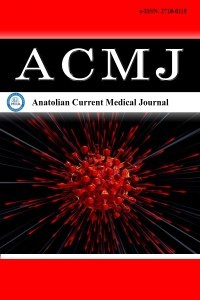1.
World Health Organization, Top 10 Global Causes of Deaths,World Health Organization, Geneva, Switzerland,2016, https://www.who.int/en/news-room/factsheets/detail/the-top-10-causes-of-death 2018.
2.
Doshi VS, Say JH, Young SH, Doraisamy P. Complications in strokepatients: a study carried out at the Rehabilitation Medicine Service,Changi General Hospital. Singapore Med J 2003; 44: 643-52.
3.
Weimar C, Roth MP, Zillessen G, et al. German Stroke Date BankCollaborators. Complications following acute ischemic stroke.Eur Neurol 2002; 48: 133-40.
4.
Davenport RJ, Dennis MS, Wellwood I, Warlow CP. Complicationsafter acute stroke. Stroke 1996; 27: 415-20.
5.
Foxman B. Epidemiology of urinary tract infections: incidence,morbidity, and economic costs. Am J Med 2002; 113: 5-13.
6.
Ersoz M, Ulusoy H, Oktar MA, Akyuz M. Urinary tract infectionand bacteriurua in stroke patients: frequencies, pathogenmicroorganisms, and risk factors. Am J Phys Med Rehabil 2007;86: 734-41.
7.
Klehmet J, Harms H, Richter M, et al. Stroke-inducedimmunodepression and post-stroke infections: lessons from thepreventive antibacterial therapy in stroke trial. Neuroscience2009; 158: 1184-93.
8.
Kong KH, Young S. Incidence and outcome of poststroke urinaryretention: a prospective study. Arch Phys Med Rehabil 2000; 81:1464-7.
9.
Schwarz S, Al-Shajlawi F, Sick C, Meairs S, Hennerici MG. Effectsof prophylactic antibiotic therapy with mezlocillin plus sulbactamon the incidence and height of fever after severe acute ischemicstroke: the Mannheim Infection in Stroke Study (MISS). Stroke2008; 39: 1220-7.
10.
Schumm K, Lam TB. Types of urethral catheters for managementof short-term voiding problems in hospitalised adults. CochraneDatabase Syst Rev 2008; 2: CD004013
11.
Guenther E. Australian tea tree oils. Report of a field survey.Perfum Essent Oil Rec 1968; 59: 642-4.
12.
Homer LE, Leach DN, Lea D, Lee LS, Henry RJ, BaverstockPR. Natural variation in the essential oil content of Melaleucaalternifolia Cheel (Myrtaceae). Biochem Syst Ecol 2000; 28: 367-82.
13.
May J, Chan CH, King A, Williams L, French GL. Time-kill studiesof tea tree oils on clinical isolates. J Antimicrob Chemother 2000;45: 639-43.
14.
Sikkema J, de Bont JA, Poolman B. Mechanisms of membranetoxicity of hydrocarbons. Microbiol Rev 1995; 59: 201-22.
15.
Carson CF, Mee BJ, Riley TV. Mechanism of action of Melaleucaalternifolia (tea tree) oil on Staphylococcus aureus determinedby time-kill, lysis, leakage, and salt tolerance assays and electronmicroscopy. Antimicrob Agents Chemother 2002; 46: 1914-20.
16.
Cox SD, Gustafson JE, Mann CM, et al. Tea tree oil causes K+leakage and inhibits respiration in Escherichia coli. Lett ApplMicrobiol 1998; 26: 355-8.
17.
Longbottom CJ, Carson CF, Hammer KA, Mee BJ, Riley TV.Tolerance of Pseudomonas aeruginosa to Melaleuca alternifolia(tea tree) oil is associated with the outer membrane and energy-dependent cellular processes. J Antimicrob Chemother 2004; 54:386-92.
18.
D’Auria FD, Laino L, Strippoli V, et al. In vitro activity of teatree oil against Candida albicans mycelial conversion and otherpathogenic fungi. J Chemother 2001; 13: 377-83.
19.
Nenoff P, Haustein UF, Brandt W. Antifungal activity of theessential oil of Melaleuca alternifolia (tea tree oil) againstpathogenic fungi in vitro. Skin Pharmacol 1996; 9: 388-94.
20.
Minami M, Kita M, Nakaya T, Yamamoto T, Kuriyama H,Imanishi J. The inhibitory effect of essential oils on herpessimplex virus type-1 replication in vitro. Microbiol Immunol2003; 47: 681-4.
21.
PENA EF. Melaleuca alternifolia oil. Its use for trichomonalvaginitis and other vaginal infections. Obstet Gynecol 1962; 19:793-5.
22.
Rocco A, Pasquini M, Cecconi E, et al. Monitoring after the acutestage of stroke: a prospective study. Stroke 2007; 38: 1225-8.
23.
Powers WJ, Rabinstein AA, Ackerson T, et al. Guidelines for theEarly Management of Patients With Acute Ischemic Stroke: 2019Update to the 2018 Guidelines for the Early Management of AcuteIschemic Stroke: A Guideline for Healthcare Professionals Fromthe American Heart Association/American Stroke Association.Stroke 2019; 50: e344.
24.
Bassett IB, Pannowitz DL, Barnetson RS. A comparative study oftea-tree oil versus benzoylperoxide in the treatment of acne. MedJ Aust 1990; 153: 455-8.
25.
Halcón L, Milkus K. Staphylococcus aureus and wounds: a reviewof tea tree oil as a promising antimicrobial. Am J Infect Control2004; 32: 402-8.
26.
Veien NK, Rosner K, Skovgaard GL. Is tea tree oil an importantcontact allergen?. Contact Dermatitis 2004; 50: 378-79.
27.
Anonymous, WHO monographs on selected medicinal plants,Vol.2 (ISBN 92 4 1545372), WHO, Geneva (2001)

